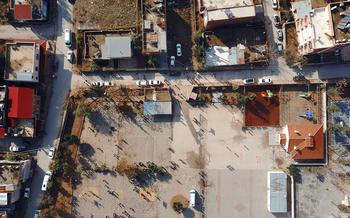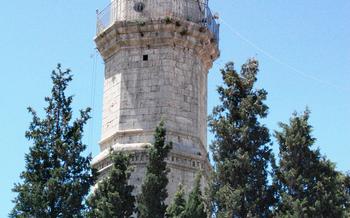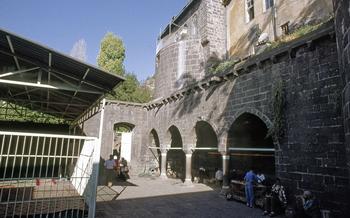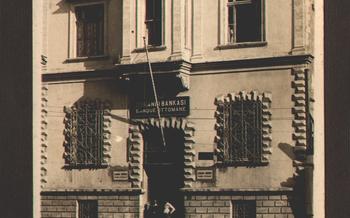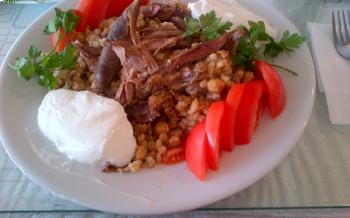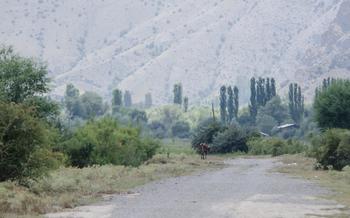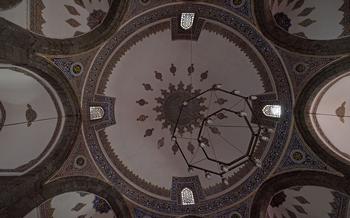
Ulu Cami (Great Mosque of Tokat)
- History of the Ulu Cami (Great Mosque of Tokat)
- Location and Accessibility
- Significance of the Ulu Cami
- Visiting Hours and Entrance Fees
- Prayer and Worship
- Exploring the Interiors
- The Courtyard and Ablution Area
- The Minaret
- The Domes
- The Mihrab
- The Minbar
- The Calligraphy
- Decorative Elements
- Insider Tip
History of the Ulu Cami (Great Mosque of Tokat)
The Ulu Cami, also known as the Great Mosque of Tokat, stands as a testament to the rich history and cultural heritage of the city. Its construction dates back to the Seljuk period in the 12th century, with the initial foundation laid by the Seljuk sultan, Kilij Arslan II. The mosque underwent subsequent renovations and additions during the Ottoman period, particularly under the reign of Sultan Murad IV in the 17th century. These architectural enhancements reflect the blending of Seljuk and Ottoman styles, resulting in a unique and captivating edifice. The Ulu Cami has served as a significant place of worship for the Muslim community in Tokat throughout the centuries, contributing to the city's religious and cultural identity.
Location and Accessibility
The Ulu Cami (Great Mosque of Tokat) is situated in the heart of Tokat, Turkey, a city renowned for its rich history and cultural heritage. The mosque's strategic location, at the intersection of several main streets and near the historical Tokat Castle, makes it easily accessible to both local residents and visitors.
To reach the Ulu Cami, various transportation options are available. For those arriving by bus or train, the mosque is a short walk from the Tokat Bus Terminal and the Tokat Railway Station. Public transportation, including buses and taxis, provides convenient connections to the mosque from different parts of the city.
Once in the vicinity of the mosque, visitors can easily spot its distinctive domes and minarets, which serve as prominent landmarks. The mosque is also surrounded by several historical and cultural attractions, including the Tokat Castle, the Armenian Church, and the Tokat Museum.
For those arriving by car, parking is available in the vicinity of the mosque, ensuring easy accessibility for visitors traveling by private vehicles. Designated parking areas can be found along the surrounding streets or in nearby parking lots.
Significance of the Ulu Cami
The Ulu Cami (Great Mosque of Tokat) holds immense significance in the cultural and religious landscape of Tokat. As a place of worship, it serves as a spiritual hub for the city's Muslim community, providing a sacred space for prayer and contemplation. The mosque's rich history, dating back to the 12th century, intertwines with the city's past, making it a symbol of Tokat's heritage and a testament to its enduring faith.
Beyond its religious significance, the Ulu Cami stands as a cultural icon, representing the city's Islamic heritage and architectural prowess. Its unique blend of Seljuk and Ottoman architectural styles showcases the evolution of Islamic architecture in the region, while its intricate carvings, calligraphy, and decorative elements reflect the artistic traditions of the era. The mosque's presence in the heart of the city serves as a reminder of Tokat's rich cultural tapestry and its deep-rooted connection to Islamic history and traditions.
Architecturally, the Ulu Cami is a testament to the genius of Seljuk and Ottoman builders. Its massive domes, soaring minarets, and spacious courtyard exemplify the grandeur and functionality of Islamic architecture. The mosque's design, with its harmonious blend of Seljuk and Ottoman elements, distinguishes it from other mosques in the region and showcases the city's architectural prowess.
The Ulu Cami's significance extends beyond its religious and cultural importance. It is a symbol of Tokat's resilience and continuity, having stood the test of time and witnessed countless historical events. Its enduring presence serves as a reminder of the city's ability to adapt and thrive, while its ongoing role as a place of worship and cultural landmark ensures its lasting legacy in the hearts and minds of the people of Tokat.
Visiting Hours and Entrance Fees
The Ulu Cami (Great Mosque of Tokat) welcomes visitors with open arms during specific hours. Tourists and worshippers can explore the mosque's grandeur from Monday to Sunday, with timings typically ranging from 9:00 AM to 5:00 PM. These hours may vary depending on prayer times and special occasions, so it's advisable to check beforehand to avoid any inconvenience.
Entrance to the Ulu Cami is free of charge, allowing everyone to experience its architectural wonders without financial barriers. This open-door policy reflects the mosque's commitment to inclusivity and its role as a symbol of unity within the community. Whether you're a devout Muslim seeking spiritual solace or a curious traveler eager to delve into Tokat's rich history, the Ulu Cami stands ready to embrace you with its timeless beauty.
For those seeking a deeper understanding of the mosque's history and significance, guided tours are available upon request. These tours, led by knowledgeable local guides, provide fascinating insights into the mosque's architectural features, religious importance, and cultural impact. While not mandatory, these tours offer an enriching experience, especially for those with an interest in Islamic history and architecture.
To fully appreciate the mosque's serene ambiance and intricate details, it's recommended to visit during the early morning or late afternoon, when the crowds are fewer. This allows for a more contemplative and immersive experience, where you can soak in the tranquility and connect with the mosque's spiritual essence.
Prayer and Worship
As a place of worship, the Ulu Cami holds immense religious significance for Muslims. Visitors should be mindful of the sanctity of the mosque and observe proper etiquette. Non-Muslim visitors are welcome to enter the mosque respectfully, but should be aware of the religious customs and practices. Modest dress is recommended, and visitors should avoid wearing shorts or revealing clothing. Upon entering the mosque, it is customary to remove shoes and place them on the designated racks. Visitors should also be respectful of the worshippers and avoid talking or making noise that may disturb their prayers. The mosque provides designated areas for men and women to perform their prayers. Visitors can observe the prayers from a distance, but should not interfere or disrupt the worshippers. The Ulu Cami offers a serene and spiritual atmosphere, inviting visitors to contemplate and reflect on their own beliefs and values.
Exploring the Interiors
As you step inside the Ulu Cami, a sense of awe washes over you. The expansive interior is adorned with intricate details that showcase the fusion of Seljuk and Ottoman architectural styles. The towering columns, each with a unique design, support graceful arches that create a sense of harmony and grandeur. The mihrab, the focal point of the mosque, is a masterpiece of craftsmanship, featuring intricate carvings and colorful tiles that depict verses from the Quran. The minbar, used for delivering sermons, is equally impressive, adorned with intricate woodwork and inlaid with mother-of-pearl.
As you wander through the mosque, take a moment to admire the stunning calligraphy that adorns the walls and ceilings. Verses from the Quran, written in elegant Arabic script, remind visitors of the mosque's religious significance. The decorative elements, such as the stained glass windows and intricate tilework, add a touch of color and vibrancy to the interior space.
It is easy to get lost in the beauty and serenity of the Ulu Cami's interior. Take your time to explore every corner, marvel at the craftsmanship, and soak in the spiritual atmosphere. Whether you are a devout Muslim or simply a curious traveler, the Ulu Cami offers a unique and unforgettable experience.
The Courtyard and Ablution Area
The courtyard of the Ulu Cami, like many other mosques, serves multiple functions and holds significant importance in Islamic architecture. It provides a spacious and serene area for worshippers to gather before and after prayers, socialize, or engage in religious discussions. The courtyard is also used for ablutions, the ritual cleansing before prayers, which is a crucial part of Islamic religious practice.
The ablution area within the courtyard typically consists of a series of fountains or taps where worshippers can perform their ablutions. These fountains are often adorned with intricate designs and inscriptions, reflecting the artistic and cultural heritage of the region. The courtyard's design facilitates easy access to water for worshippers, ensuring that they can perform their ablutions conveniently and efficiently before entering the mosque for prayers.
The serene atmosphere of the courtyard, with its open sky, lush greenery, and calming water features, provides a tranquil space for contemplation and reflection. It offers a moment of pause and serenity before worshippers enter the sacred space of the mosque, allowing them to transition from the outside world to the spiritual realm within.
The Minaret
Minarets, the towering structures that adorn mosques, hold a significant place in Islamic culture. In the Ulu Cami, the minaret stands as a symbol of the mosque's grandeur and its importance as a place of worship. Its architectural design is a testament to the skill and artistry of the Seljuk and Ottoman builders.
The minaret's slender cylindrical form rises towards the sky, tapering as it ascends. Constructed using intricate stonework and adorned with decorative bands, it exhibits the characteristic architectural style of the period. Its surface is embellished with intricate carvings and inscriptions that add to its aesthetic appeal.
The minaret's primary function is to serve as a platform for the muezzin to call the faithful to prayer. Its elevated position ensures that the call to prayer, echoing through the streets of Tokat, can be heard by all. The muezzin's melodic voice reverberates through the air, inviting the community to join in prayer and worship.
If accessible, visitors can climb the narrow spiral staircase within the minaret to reach its summit. The effort is rewarded with breathtaking panoramic views of Tokat city and the surrounding landscape. From this vantage point, one can appreciate the urban fabric of Tokat, with its historic buildings, bustling streets, and the meandering Tokat River. The panoramic vista offers a unique perspective on the city's rich history and cultural heritage.
The Domes
Architectural domes hold immense significance in Islamic architecture, symbolizing the heavens and representing the unity and omnipotence of God. In the Ulu Cami, the domes play a crucial role in shaping its visual appeal and sacred atmosphere. Constructed with intricate techniques and adorned with geometric patterns, the domes showcase the expertise of Seljuk and Ottoman architects.
The main dome, towering over the prayer hall, is a testament to the mosque's grandeur. Its vast size and elegant proportions create a sense of awe and reverence among visitors. The smaller domes, situated above the side aisles and porches, complement the main dome and add a sense of symmetry to the mosque's overall design.
Beyond their aesthetic beauty, the domes also carry symbolic and religious meanings. The circular shape of the domes represents eternity and the infinite nature of God's existence. The intricate patterns and motifs adorning the domes often incorporate verses from the Quran or Islamic geometric designs, emphasizing the mosque's spiritual significance.
Overall, the domes of the Ulu Cami stand as remarkable examples of Islamic architecture, blending aesthetics, symbolism, and religious meaning to create a truly awe-inspiring space for worship and contemplation.
The Mihrab
The mihrab, a niche in the wall of a mosque indicating the direction of Mecca, is a focal point of the Ulu Cami. Intricately designed and crafted, it stands as a testament to the mosque's grandeur and religious significance. Constructed from finely carved stone or marble, the mihrab features intricate geometric patterns, floral motifs, and verses from the Quran. Its pointed arch, adorned with elaborate calligraphy, frames the qibla, the direction towards which Muslims face during prayer. The mihrab's design serves not only as a guide for prayer but also as a symbol of the mosque's spiritual essence, inviting worshippers to connect with the divine.
The Minbar
Symbol of Authority and Guidance
The minbar, an elevated platform used for delivering sermons and speeches, holds a significant position within the Ulu Cami. Its design and craftsmanship reflect the mosque's overall architectural style, blending Seljuk and Ottoman influences. Constructed from intricately carved wood, the minbar features geometric patterns, floral motifs, and verses from the Quran, showcasing the artistic prowess of its creators.
The minbar serves as a symbol of authority and guidance, representing the role of religious leaders in the community. Its elevated position allows the speaker's voice to carry throughout the mosque, ensuring that the message is heard by all worshippers. The intricate carvings and inscriptions on the minbar add to its aesthetic appeal, making it a focal point of the mosque's interior.
Beyond its practical function, the minbar carries symbolic and religious significance. The choice of materials, the design motifs, and the verses inscribed on it all contribute to its spiritual meaning. The minbar represents the connection between the earthly realm and the divine, serving as a reminder of the importance of seeking guidance and knowledge in religious matters.
Practical Information:
- The minbar is typically located near the mihrab, the prayer niche indicating the direction of Mecca.
- Visitors are generally allowed to admire the minbar from a distance, but climbing or touching it is usually prohibited.
- The mosque may offer guided tours that provide insights into the symbolism and significance of the minbar.
The Calligraphy
The art of calligraphy holds a profound significance in Islamic culture, serving as a sacred form of expression within religious and cultural contexts. The Ulu Cami of Tokat is adorned with exquisite calligraphy that adorns its walls, arches, and mihrab, adding to the mosque's spiritual and aesthetic allure.
Skilled calligraphers meticulously inscribed verses from the Quran, hadiths, and poetic invocations using various calligraphic styles, including Kufic, Thuluth, and Naskh. These inscriptions not only enhance the visual appeal of the mosque but also serve as a reminder of the mosque's religious significance and provide a tangible connection to the teachings of Islam.
Beyond their religious importance, the calligraphy in the Ulu Cami also showcases the artistic prowess and creativity of the calligraphers who dedicated their skills to beautifying the house of worship. Each stroke and flourish of the pen reflects the deep devotion and reverence for Islamic tradition, transforming the mosque into a living testament to the enduring power of calligraphy.
As visitors admire the intricate calligraphy that adorns the Ulu Cami, they are reminded of the rich artistic heritage and spiritual essence that permeates every corner of this sacred space. The calligraphy serves as a reminder of the enduring power of faith and the enduring beauty of Islamic art and culture.
Decorative Elements
The Ulu Cami is adorned with a rich array of decorative elements that reflect the artistic traditions of the Seljuk and Ottoman periods. From intricate carvings and moldings to colorful tiles and stained glass windows, the mosque's ornamentation is a testament to the skill and artistry of its creators. The decorative elements serve not only to enhance the visual appeal of the mosque but also to convey religious and symbolic meaning.
Geometric patterns and arabesques are prominent throughout the mosque, representing the unity and harmony of the universe. Calligraphic inscriptions in Arabic script adorn the walls and arches, featuring verses from the Quran and the names of Allah and the Prophet Muhammad. These inscriptions serve as a reminder of the mosque's religious purpose and provide a beautiful example of Islamic calligraphy.
Floral motifs and stylized vegetal patterns add a touch of nature and beauty to the mosque's interior. These intricate designs often incorporate symbolic meanings, such as the lotus flower, which represents purity and enlightenment. The use of colorful tiles and stained glass windows further enhances the mosque's visual appeal, creating a vibrant and harmonious interior space.
Insider Tip
Local Customs and Traditions: When visiting the Ulu Cami, it's essential to respect local customs and traditions. Dress modestly, covering your shoulders and knees. Remove your shoes before entering the mosque and maintain a respectful demeanor, avoiding loud noises or distractions.
Recommended Restaurants: After your visit, indulge in the local cuisine at nearby restaurants. Try traditional Turkish dishes like Tokat kebabı or keşkek at renowned establishments like Sofuoğlu Kebap Salonu or Tokat Kebabı Evi.
Unique Photo Spots: Capture the mosque's beauty from various angles. Head to the courtyard to photograph the harmonious blend of architectural elements. For a panoramic view, climb the minaret (if accessible) and capture the cityscape with the mosque as the centerpiece.
Seasonal Events and Festivals: During the holy month of Ramadan, the mosque transforms into a vibrant hub of activity. Join the locals for special prayers, communal meals, and celebrations that showcase the spiritual essence of the mosque.
